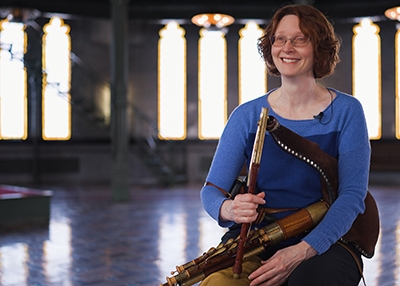Kara Doyle was in the middle of a busy holiday season, with visiting parents and a half-finished kitchen remodel.
So she could be forgiven for dismissing an email from “Elvis Costello” as another version of the Nigerian prince scam or a prank by a friend.
But the second email, this one signed by Declan McManus (Costello’s birth name), sparked her curiosity.
When she responded, it was THE Elvis Costello, the multi-Grammy-winning member of the Rock and Roll Hall of Fame. He was assembling a group to back songs during a concert, and had found Doyle’s website.
The professor of English, Chaucer specialist and Dean of Academic Departments and Programs also happens to be an accomplished player and teacher of uilleann pipes, a mainstay of Irish music.
On Feb. 10, less than two months after that email exchange, Doyle was one of five musicians backing Costello for a sold-out performance at New York’s Gramercy Theater, where Costello was doing a 10-night run. With Doyle were Brigid Kaelin, accordion; Eleanor Whitmore, fiddle; Colin Nairne, mandolin; and Tony Garnier, bass.
“Long story short,” recalled Doyle, “I had the most remarkable musical night of my life playing onstage with Elvis Costello and a stellar ensemble of talented, generous, funny musicians.”
Doyle played a solo at the end of “Little Palaces” and segued into an Irish jig at 3:30 of this video.
The uilleann pipes (pron. ILL-in), a cousin of the highland bagpipes, have fingerholes similar to a recorder but have a reed like that of an oboe. Air comes from bellows controlled by the elbow. (“Uilleann” is the Irish word for “elbow.”)
The pipes almost died out in the 1950s, Doyle said, but have enjoyed a revival after decades of advocacy and preservation work by piping organizations in Ireland and elsewhere.
Besides being difficult to play, the pipes are sensitive to changes in temperature and humidity. Warm and moist air is best. Doyle checks the weather forecast before a gig.
Conventional wisdom says it takes 21 years to master the uilleann pipes: seven years listening, seven practicing, seven playing, according to Doyle.
She caught “uilleann piping fever” during grad school at Cornell in the late 90s when she was playing the whistle in an Irish music session. Encouraged by the group’s piper, she found a maker, a handful of teachers and some workshops where she could meet other pipers.
“Starting out, I sounded like a wounded goose,” she recalls. “My dog was very unhappy.”
Today, she offers private lessons and workshops in person and online. She performs at weddings and other events. She is a member of two groups, the Broken String Band and Curragh, and has performed at festivals and concerts throughout the region.
Irish music, long dominated by men, is undergoing a change. “When I started piping in 2001, I didn’t know many female pipers at all,” Doyle said. “There’s a whole community of us now and that’s been really great.”
“If you know the music and you’re a decent player, you can go anywhere in the world,” she said. “There’s a social aspect of the music and the culture of the tradition, and the people I’ve met are like a second family.”

